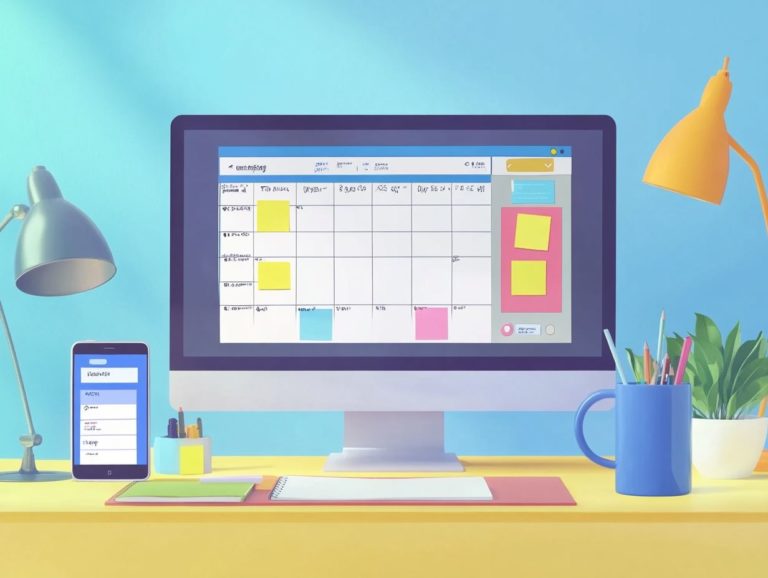5 Simple Strategies for Prioritizing Tasks
In today s fast-paced world, mastering the art of task prioritization is crucial for achieving your goals and enhancing your productivity. With a myriad of responsibilities competing for your attention, determining what to tackle first can make a significant impact.
This article presents five straightforward strategies designed to help you streamline your workload. You ll learn how to create a clear to-do list, leverage the 80/20 rule, explore common pitfalls, discover motivational techniques, and familiarize yourself with practical tools that keep you on track.
Get ready to supercharge your productivity! Let s dive in!
Contents
- Key Takeaways:
- 1. Create a To-Do List
- 2. Identify Urgent and Important Tasks
- 3. Use the 80/20 Rule
- 4. Consider Deadlines and Consequences
- 5. Delegate or Outsource Tasks
- How Can Prioritizing Tasks Improve Productivity?
- What Are the Common Mistakes People Make When Prioritizing Tasks?
- How Can One Stay Motivated to Complete Prioritized Tasks?
- What Are Some Tools or Techniques for Prioritizing Tasks?
- How Can One Re-Evaluate Their Priorities When Circumstances Change?
- What Are Some Tips for Maintaining a Balanced Workload When Prioritizing Tasks?
- Frequently Asked Questions
Key Takeaways:

- Make a to-do list to keep track of tasks and avoid forgetting important items.
- Distinguish urgent and important tasks to focus on the most crucial ones first.
- Use the 80/20 rule to identify tasks that will yield the most significant results.
1. Create a To-Do List
Creating a well-structured to-do list is a foundational step in managing your tasks, enabling you to streamline your responsibilities and enhance your productivity. It provides clear visibility into your daily tasks and action items.
By categorizing your tasks by urgency levels, you can easily pinpoint which items demand immediate attention and which can wait. This method alleviates stress and fosters a satisfying sense of accomplishment.
Breaking larger responsibilities into smaller, manageable chunks transforms daunting projects into achievable goals, keeping your motivation high throughout the day. Set daily goals that are within reach to keep your motivation high!
A thoughtfully constructed to-do list acts as your roadmap, guiding you toward personal and professional success with clarity and purpose.
2. Identify Urgent and Important Tasks
To prioritize effectively, you must distinguish between urgent and important tasks. This alignment with long-term goals optimizes your decision-making through a clearly defined priorities framework.
Using a tool like the Eisenhower Matrix helps you categorize tasks into four quadrants: urgent and important, important but not urgent, urgent but not important, and neither urgent nor important. This method clarifies which duties demand your immediate attention and highlights those that contribute meaningfully to your overarching objectives.
Such effective prioritization enhances your productivity and reduces stress, ultimately leading to better time management.
When you assess tasks correctly, you’re enabled to allocate resources efficiently, fostering a work environment where progress can truly thrive.
3. Use the 80/20 Rule
Applying the 80/20 rule, or the idea that a small number of tasks can lead to most of your results, significantly elevates your task prioritization strategy. To enhance this approach, you can learn how to prioritize your daily tasks effectively, helping you pinpoint high-priority tasks that deliver the most impactful results with minimal effort.
This principle encourages you to examine your responsibilities more effectively, focusing on the 20% of tasks that yield 80% of your desired outcomes. For instance, in sales, you might find that a small portion of your clients generates the bulk of your revenue. Concentrating your efforts on nurturing these key accounts can drive substantial profits while streamlining your workload.
Similarly, as a project manager, you might identify a handful of critical milestones that greatly influence project success. Dedicating resources to these pivotal elements can enhance overall team performance, leading to timely project completion and boosted morale.
4. Consider Deadlines and Consequences

When prioritizing tasks, consider clear deadlines and potential consequences. For better effectiveness, you might find it helpful to explore 5 tips for prioritizing long-term projects, as this helps identify urgent tasks that need immediate attention.
This strategy fosters a sense of accountability and boosts your overall productivity. Recognizing that each task comes with its own timeline encourages you to allocate your efforts wisely, reducing the chances of overlooking critical responsibilities.
With a refined focus on deadlines, your workflow becomes more organized. As a result, you navigate your workload more smoothly and cultivate a mindset that values time management, ensuring that essential tasks remain prioritized even amidst competing demands.
5. Delegate or Outsource Tasks
Effective task management often requires you to delegate or outsource tasks, allowing your team to collaborate in a structured manner. This approach ensures that everyone can focus on their highest-priority tasks.
By adopting this strategy, you enhance overall efficiency and cultivate a sense of ownership among your team members as they contribute to various facets of the workload. Begin by assessing your team members’ skills to identify tasks suitable for delegation, ensuring alignment with those best equipped to handle them.
Next, pinpoint repetitive or lower-priority tasks that someone else could manage, freeing up key personnel for more strategic initiatives. Ultimately, nurturing a culture of teamwork and shared responsibility is crucial in propelling collective goals forward. Each member plays a vital role in the organization s success.
How Can Prioritizing Tasks Improve Productivity?
Effectively prioritizing your tasks can lead to a remarkable boost in productivity. By focusing on high-impact actions and applying 5 ways to stay focused on your priorities, you improve your work performance and achieve clear outcomes that align with your long-term goals.
This streamlined approach enables you to identify critical tasks that resonate with your larger objectives. For instance, when you prioritize urgent client needs over routine tasks, you elevate client satisfaction and nurture stronger relationships that may yield future benefits. Utilizing key techniques for setting priorities can further enhance this process.
Organizing your daily activities around significant projects ensures that your energy is directed toward what truly matters, enhancing both efficiency and motivation.
Excelling at prioritizing tasks can skyrocket your success, making every action count and supporting your journey toward personal and professional aspirations.
What Are the Common Mistakes People Make When Prioritizing Tasks?
Understanding common mistakes in prioritizing tasks is crucial for elevating your productivity. It s easy to mistake urgent tasks for important ones, which can lead to ineffective prioritization.
This misalignment doesn t just hinder your daily efficiency; it can also sideline long-term goals that demand your consistent attention. Often, individuals neglect to establish clear urgency categories. Don t fall into the reactive trap! Instead, establish these categories to better prioritize tasks.
Consider using the Eisenhower Matrix, a tool that helps you categorize tasks into urgent and important. By setting specific timeframes for your long-term objectives, you can maintain focus and ensure that your immediate actions align with broader aspirations.
By implementing these strategies, you can refine your task management skills and ensure that your priorities not only address urgent needs but also pave the way for long-term success. Check out these 7 tips for effective task prioritization and start implementing them today for a more productive tomorrow!
How Can One Stay Motivated to Complete Prioritized Tasks?

Staying motivated to tackle your prioritized tasks can sometimes feel like an uphill battle. However, adopting effective productivity strategies can transform those daunting tasks into manageable milestones that instill a sense of accomplishment.
One powerful technique is breaking larger tasks into bite-sized chunks. This allows you to approach each segment without being overwhelmed. By setting clear deadlines, you create a sense of urgency that drives consistent progress.
As you navigate through these tasks, take a moment to reward yourself for reaching specific benchmarks. Celebrating those small victories whether it s indulging in a treat or enjoying a well-deserved moment of relaxation reinforces positive behavior and keeps your enthusiasm alive. These practices make the journey more enjoyable and significantly increase your chances of completing your overall tasks.
What Are Some Tools or Techniques for Prioritizing Tasks?
Utilizing the right productivity tools and techniques for prioritizing tasks can significantly elevate how you manage tasks. One effective method is through visualization for prioritization, which allows for structured organization and a more efficient workflow.
By embracing digital task management applications like Teamwork.com, you can effortlessly visualize your workload, set deadlines, and collaborate on projects in real-time. Traditional methods, such as the Eisenhower Matrix, provide a straightforward visual aid to help you categorize tasks based on urgency and importance.
Each approach has unique advantages. Digital tools often come equipped with reminders and progress tracking, while frameworks like the Eisenhower Matrix encourage thoughtful decision-making. Together, these methods enable you to effectively juggle competing priorities, ensuring that critical tasks receive the attention they deserve. This ultimately leads to a significant boost in your productivity.
How Can One Re-Evaluate Their Priorities When Circumstances Change?
Re-evaluate your priorities regularly to stay productive and on track! Flexibility is key when adjusting urgency categories and re-assessing the importance of tasks.
To enhance your effectiveness, consider implementing regular check-ins, whether daily or weekly, to assess your progress and recalibrate your goals. This structured approach allows you to reflect on your accomplishments and recognize any urgent needs that may have shifted since your last assessment.
Utilizing tools like to-do lists or digital planners can greatly facilitate this ongoing evaluation. By prioritizing adaptability and keeping an open mindset, you can better align your efforts with emerging opportunities and challenges. This ultimately leads to a more balanced and productive workflow.
What Are Some Tips for Maintaining a Balanced Workload When Prioritizing Tasks?
Maintaining a balanced workload while prioritizing tasks is crucial for your long-term success. You can achieve this through thoughtful organization and by following guidelines for effective task prioritization.
Incorporate strategic techniques like scheduling regular breaks. This rejuvenates both your mind and body, enhancing your focus when you return to work. Setting realistic goals ensures that your workload remains manageable and helps prevent the burnout that often arises from overcommitting.
Monitor the complexity of your tasks. Breaking down larger projects into smaller, achievable steps can make even the most daunting assignments feel more approachable.
Together, these strategies create a work environment that fosters sustained productivity while supporting your overall well-being. This allows you to achieve your goals while maintaining a healthy work-life balance.
Frequently Asked Questions

What are 5 simple strategies for prioritizing tasks?
The 5 simple strategies for prioritizing tasks are: 1) Create a to-do list, 2) Identify urgent and important tasks, 3) Use the Eisenhower Matrix, 4) Consider deadlines, and 5) start with the most difficult tasks.
How can a to-do list help with prioritizing tasks?
A to-do list helps prioritize tasks by providing a clear overview of what needs to be done. This helps you determine which tasks are most important or urgent.
What is the Eisenhower Matrix?
The Eisenhower Matrix is a helpful tool that categorizes tasks into four quadrants. This method allows you to tackle tasks that are urgent and important first.
Why are deadlines important when prioritizing tasks?
Deadlines help you prioritize tasks based on when they are due. This way, you complete tasks on time and avoid missing important deadlines.
Why start with the most difficult tasks?
Starting with the hardest tasks boosts productivity and motivation. Completing these first gives you a sense of accomplishment and makes the rest of your tasks easier.
How often should I re-evaluate my priorities?
Make it a habit to re-evaluate your priorities daily or weekly. This keeps you on track and allows adjustments based on changing circumstances.






